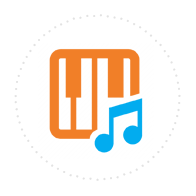Musika Quick Stats
24 Years
Since We Started
41,456+
Happy Customers
10,769
Cities with Students
3,123
Teachers in Network
Lesson Special - Up to 20% OFF! Get Started Now with a Risk-Free Trial!
Here are just a few of the many teachers offering Violin lessons in Anaheim . Whether you are looking for beginner guitar lessons for your kids, or are an adult wanting to improve your skills, the instructors in our network are ready to help you now!
Instruments: Violin Electric Violin
My teaching method is mainly the combination of The Juilliard School of Music and Suzuki Method. Lessons are specifically designed to fit individual students age, background, strength and personality. In my classes, not only students are taught how to play the violin, they are also taught ear training, sight-reading, music theory, and performance skills; Most importantly, students are also taught self-confidence, discipline, appreciation of the arts, and the pride that comes from a job well done. Read More
Instruments: Violin
My teaching style is focused and intentional. I take into account every student and her or his needs. That being the case, I create detailed plans for the students week as far as practice is concerned. There will be listenings on each weeks assignments, detailed notes so as to make sure the student has all the necessary information to best succeed during the week between lessons. The best way to learn is to teach someone what you have learned. Read More
Instruments: Piano Violin Trombone Saxophone Clarinet
Having studied Music for almost 20 years I have always wanted to give the gift of music to others through education. After high school I became a marching band coach for 3 years assisting in teaching various sections and leadership positions. I have performed in many cities across the United States as well as internationally. I have had the opportunity to perform in several musical productions both on stage and in the pit orchestra, musicals from Miss Saigon, Phantom of the Opera, The Music Man, Footloose, Anything Goes, to Ragtime. Read More
Instruments: Violin Viola
I started teaching while I was in college. There is this program at my university that allows music majors to teach private lessons and after school programs. Since I was interested in pursuing a career in music education, this was the perfect learning opportunity for me. This is where I really found that I love teaching private lessons. I love seeing my students grow, especially when they were having a hard time grasping a certain concept. Read More
Instruments: Piano Guitar Violin Saxophone Bass Guitar Organ Acoustic Guitar
My goal for every student especially the beginners is to make them play like a pro as soon as possible with emphasis on playing music by ear. My way of teaching is kind of unconventional because based on my experience, it took me a long time before I was able to play any song that I like since reading notes would require unwavering attention and huge effort depending on student’s skills to be able to play it perfectly. Read More
Instruments: Piano Guitar Violin Cello Viola Trumpet Trombone Saxophone Flute Clarinet Recorder Fiddle French Horn Piccolo Oboe
Hi, my name is Max. I graduated CSULB with a degree in Music Education. My main instruments is the violin but I enjoy playing and teaching most of the band and orchestra instruments. I am a string specialist (Violin, Viola Cello and Bass) but I also teaching flute, clarinet, saxophone, oboe, trumpet, trombone and piano. Each instrument is special in its own way, and I enjoy teaching and playing each one. Read More
Instruments: Violin
Im a working composer, hailing from the Pacific Northwest, who is familiar with both the rigors of musicianship and the exploratory nature of creative work. I was awarded a masters degree in 2012 from Western Washington University where I also began a lengthy creative partnership with a non-profit dance company. Additionally, I lent my talents to some of the finest animators in the Seattle area, scoring works appearing at the Sundance Film Festival, the Seattle International Film Festival, nytimes.com, vanityfair.com, and numerous other venues. Read More
Instruments: Violin Viola
If you have a Music Degree, what is it in (Performance, Education, Musicology, Theory, Composition, etc) and why did you choose that degree?
My Bachelor of Music was a concentration in Violin Performance. I chose this path because I primarily wanted to be a performer able to play in orchestras and live music settings. I was also lucky enough to have a teaching internship during college, so although I was giving recitals and learning major violin repertoire, I was also learning how to be a better teacher.
My performance education has allowed me to do everything I want to do because it was a well rounded program. I am able to perform with orchestras and popular artists as well as teach many students!
What does a normal practice session look like for you?
A normal lesson with me begins with scales and technical exercises. We go over things like posture, bow hold, and left hand position in the first portion of the lesson. The student focuses on intonation, bowing straight, and making a solid sound. After scales and etudes, we move to any repertoire the student is working on. For younger students, it is generally something out of the Suzuki books. For older students, it is generally a more advanced piece, or any orchestra repertoire they are working on in their school or youth orchestra. While practicing repertoire, we focus on musicality as well as technique.
Do you use specific teaching methods or books? (Ex: Alfred, Bastion, Suzuki, Hal Leonard) Why did you choose them if you did?
I teach the Suzuki Method as well as All for Strings method books for beginners. My more advanced students use the Carl Flesch Scale Book, as well as standard etude books (Sevcik, Dont, Wolfhart, Dounis, etc.) I grew up learning the Suzuki method, so naturally when I began teaching, those were the books I was most comfortable with. The Suzuki method is a wonderful way for students to learn skills through playing pieces. I find it makes students excited because they are actually getting to play a song rather than only scales or etudes.
I supplement the Suzuki method with All for Strings so students get comfortable with note reading and technique early on.
When did you decide to become a professional musician? Was it a gradual decision or was there a defining moment for you?
My decision to become a professional musician was a gradual one. I began playing the violin when I was eight years old. As I got older, I also became very involved in musical theatre. My schedule was filled with violin lessons and practice as well as stage productions and rehearsals. At some point the violin became my main focus, and I knew I wanted to pursue it in college. I had always been on the music career path in my private lessons, but once I decided to audition for colleges, I had to work even harder and prepare for my professional music education.
24 Years
Since We Started
41,456+
Happy Customers
10,769
Cities with Students
3,123
Teachers in Network
Trusted as the industry leader, for over 21 years the teachers in our network have been providing Violin lessons in Anaheim to students of all ages and abilities.
We'll then reach out to the teachers for you.
Schedule the risk-free trial lesson directly with the teacher.
Continue with that teacher or try someone else.








June
I am looking to rates for violin lessons for my daughter of 10 years of age. She is in Kids Orchestra during the school year but during the summer she is clueless.
Nancy
My 10 year old would like to start taking violin lessons again. He took 1 year of lessons in 3rd grade, so he would basically be starting over. Thank you
Eric
I would like to check availability and pricing for in person violin lessons at 7 or 7:30pm one night during the week, and possibly for one online lesson a week as well.